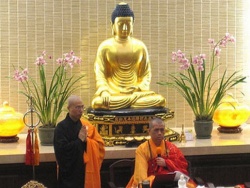Difference between revisions of "Three stages of worthiness"
(Created page with "thumb|250px| <poem> '''three stages of worthiness''' [三賢・三賢位] (Jpn san-gen or san-gen-i ) Also, three worthies or three grades of worthi...") |
|||
| Line 1: | Line 1: | ||
[[File:JianDeng.jpg|thumb|250px|]] | [[File:JianDeng.jpg|thumb|250px|]] | ||
<poem> | <poem> | ||
| − | + | [[three stages of worthiness]] | |
| − | [ | + | [[三賢]]・[[三賢位]] (Jpn [[san-gen]] or [[san-gen-i]] ) |
| − | Also, three worthies or three grades of worthiness. Stages of practice in the Hinayana teachings. | + | Also, three worthies or three grades of worthiness. Stages of practice in the [[Hinayana]] teachings. |
| − | The first of the three stages of worthiness is the stage of five | + | The first of the [[three stages of worthiness]] is the [[stage of five meditations]]—the [[five meditative practices]] for eliminating [[greed]], [[anger]], [[foolishness]], [[attachment]] to the [[idea]] of a [[permanent]] [[self]], and distractedness of the [[mind]]. |
| − | The second is the stage of observing the objects of meditation respectively. This means to meditate on each of the four objects of | + | The second is the stage of observing the [[objects]] of [[meditation]] respectively. This means to [[meditate]] on each of the [[four objects of meditation]]—[[body]], [[sensation]], [[mind]], and things—and to {{Wiki|perceive}} [[body]] as impure, [[sensation]] as marked by [[suffering]], [[mind]] as [[impermanent]], and things as without [[self]]. |
| − | The third is the stage of observing all the objects of meditation, i.e., the above four objects, as a whole. Along with the four good roots, the three stages of worthiness constitute the seven expedient means. One who has attained the seven expedient means enters the way of insight, or the first of the three ways, the second being the way of practice, and the third, the way of arhat. The seven expedient means are preparatory practices leading to the way of insight. The concept of three stages of worthiness also appears in Mahayana Buddhism, in which it refers to stages of bodhisattva practice. | + | The third is the stage of observing all the [[objects]] of [[meditation]], i.e., the above four [[objects]], as a whole. Along with the [[four good roots]], the [[three stages of worthiness]] constitute the seven [[expedient means]]. One who has attained the seven [[expedient means]] enters the way of [[insight]], or the first of the [[three ways]], the second being the way of practice, and the third, the way of [[arhat]]. The seven [[expedient means]] are [[preparatory practices]] leading to the way of [[insight]]. The {{Wiki|concept}} of [[three stages of worthiness]] also appears in [[Mahayana Buddhism]], in which it refers to stages of [[bodhisattva]] practice. |
</poem> | </poem> | ||
{{R}} | {{R}} | ||
Revision as of 23:25, 10 February 2014
three stages of worthiness
三賢・三賢位 (Jpn san-gen or san-gen-i )
Also, three worthies or three grades of worthiness. Stages of practice in the Hinayana teachings.
The first of the three stages of worthiness is the stage of five meditations—the five meditative practices for eliminating greed, anger, foolishness, attachment to the idea of a permanent self, and distractedness of the mind.
The second is the stage of observing the objects of meditation respectively. This means to meditate on each of the four objects of meditation—body, sensation, mind, and things—and to perceive body as impure, sensation as marked by suffering, mind as impermanent, and things as without self.
The third is the stage of observing all the objects of meditation, i.e., the above four objects, as a whole. Along with the four good roots, the three stages of worthiness constitute the seven expedient means. One who has attained the seven expedient means enters the way of insight, or the first of the three ways, the second being the way of practice, and the third, the way of arhat. The seven expedient means are preparatory practices leading to the way of insight. The concept of three stages of worthiness also appears in Mahayana Buddhism, in which it refers to stages of bodhisattva practice.
